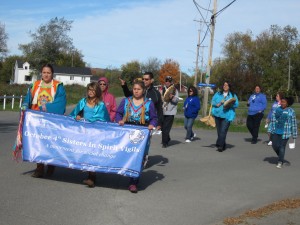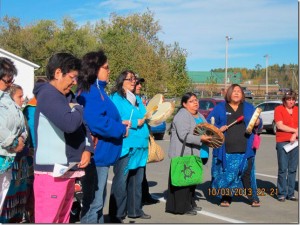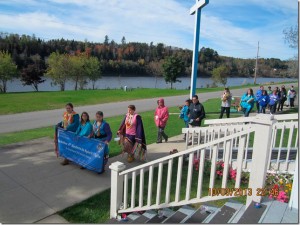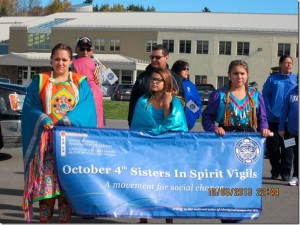Sisters in Spirit Vigil

The movement started with a daughter’s vision. Bridget Tolley was worried that people were forgetting about her mother, Gladys Tolley, who was murdred in 2001 in Maniwaki, Quebec.
Bridget asked that a vigil be held in 2006 on the steps of Parliament Hill to honour her mother, as well as the more than 600 missing and murdered Aboriginal women and girls nation-wide.
The Sisters in Spirit movement has become a call for action to bring public awareness to the violence and injustice faced every day by Aboriginal women.
The Sisters in Spirit vigil at Tobique First Nation was organized by Danielle Meekis, Mary Anne Sappier, Roxanne M. Sappier, Tatawnyha Nicholas, Tann Pirie-Wilson and Tara Perley.
Over 50 people took part in the vigil, which was held at the Negotkuk Health Center.

Paul Bear lighted the Sacred Fire and made the traditional tobacco offering as the Women Drummers sang.
Marina Moulton, Alex Moulton and Tanna Pirie-Wilson performed the drumming and singing ceremony.
After the welcoming statement was read, the SIS Vigil March began. The RCMP provided an escort as the vigil marched through the community singing and drumming, and bearing the Sisters in Spirit banner.

Many people outside of the Aboriginal communities are unaware of the numbers of missing and murdered Aboriginal women.
Momentum is building, however, as First Nations people across the country are rising up and calling for action.
Because many of these missing women were already living a marginalized lifestyle, their disappearances and murders have not been investigated as they should have been.
But they had families, they were loved, and this tragedy needs to be addressed by all citizens of Canada.
If 600 white women and girls had gone missing or been murdered the response would have
been far different….there would have been an outraged public outcry and demand for justice long before now.

An inquiry would be a crucial step in implementing a comprehensive and coordinated national action plan to bring awareness to this ongoing tragedy.
Such a response is absolutely needed to address the scale and violence faced by Aboriginal women and girls across the nation.
Together, we must demand action and secure commitments from all levels of government.
Vigils take many forms….a rally, a candlelight vigil or a gathering of people to share memories and a meal. The SIS vigils have become a movement for social change and a reminder that our sisters will not be forgotten.
(Thank you to Tanna Pirie-Wilson for the text and information, and to Mary Anne Sappier for the photos)
